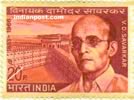| Postal Stamp Image |
: |
 |
| Stamp Issue Date |
: |
28/05/1970 |
| Postage Stamp Dinomination |
: |
0.20 |
| Postal Stamp Serial Number |
: |
0614 |
| Postal Stamp Name |
: |
V.D. SAVARKAR & CELLULAR JAIL |
| Stamp Information |
: |
The life of Vinayak Damodar Savarkar is a story of resistance,strife, struggle, suffering and sacrifice for the cause of political, social and economic emancipation of India. V.D. Saverkar was born on28th May, 1883 at Bhagur a village near Nasik, in a family of Chitpavan Brahmins, a community which has produced noted revolutionaries like Nana Saheb (of 1857 fame) and Lokmanya Tilak.
Savarkar matriculated from Nasik and went to Poona where he joined the Fergusson College. There, he found group of students, who vowed themselves to a spartn way of life in the cause of country's freedom.
In 1904, Savarkar, still an under-graduate, convened a meeting of nearly 200 of his trusted comrades and founded the "Abhinav Bharat"- an organisation dedicated to wresting freedom from the British rulers, if necessary with the help of arms. After graduation in 1905, he studied law in Bombay. The following year Savarkar went to London to study law on a schoarship on the recommendation, among others of Lokmanya Tilak and ni due course, was admitted in Gray's Inn. Soon, the young revolutionary started the "Free India Society" in London as a recruiting ground for his secret organisation, the "Abhinav Bharat" and enfolled a number of Indians including Madame Cama.
Repression in India continued to agited the minds of the mumbers of the "Abhinav Bharat", and on July 1,1909, one of the members, Madan Lal Dhingra shot and killed Cuzon Wyllie in the hall of Imperial Institute. This incident shook London and Savarkar came under suspicion. As a result, when he passed the final examinationof the Gray's Inn, the benchers of the Inn declined to confer the degree upon Savarkar, unless Savarkar give a written understanding that he would not participate in politics. Savarkar rejected the offer.
In London, Savarkar, wrote a book entitled the "First war of Independence" about the 1857 revolution. This book was promptly confiscated by the Government even before its publication. Later, Veer Savarkar was arrested in London in 1910 in connection with the Nasik Conspitacy case. When he was being taken by ship to India for trial, off Marseilles, Savarkar jumped into the sea and swamto the French coast braving the flringfrom the ship. He was arrested at Marseilles by the British Police. The French Government protested against this arrest on French soil to the Hague International Court. This brought Veer Savarkar and other Indian freedom fighters to prominence throughout the world.
Savarkar was tried for sedition in 1910 at Bombay and was sentenced to double transportation for life totalling about 50 years rigorous imprisonment. He was lodged in the Cellular Jail in the Andamans where he spent 12 long years of hard labour. This did not, in any way, dampen his spirit or quench his thirst for freedom.
Veer Savarkar was broughtto Tantnagiri in 1924 and was interned there till 1937, he joined the Hindu Mahasabha for about seven years. Veer Savarkar worked relentlesslyfor the removal of untouchability through the Hindu Mahasabha. He build a temple called "Patit-Pawan Mandir" and appointed a 'harijan' as the priest in attendance.
When British Government was holding talks with the Indian political leaders, Veer Savarkar had participated on behalf of the Hindu Mahasabha inthe discussions connected with the Cripps Mission and Wavell Plan and Sressed the need for keeping. India united. Veer Savarkar was the happiest man when India achieved freedom in 1947. In 1951, he dissolved the revolutionary organisation "Abhinav Bharat" and devoted his time and energy for the ideals of the Hindu Mahasabha.
On February 26,1966, Veer Savarkar passed away at the ripe old age of 83. His memory will always remain green in the hearts of his countrymen, and he will always be counted among the great men of his generation.
The P.& T. Department is proud to celebrate the memory of this great son of India by issuing a special commemorative stamp in his honour. |
| Philatelic Stamp Description |
: |
The design of the stamp is horizontal and depicts a portrait of V. D. Savarkar along with a picture of Cellular Jail at Port of Blair in the background. |
| Stamp Currency |
: |
P |
| Stamp Type |
: |
COMMEMORATIVE |
| Stamp Language |
: |
English |
| Stamp Overall Size |
: |
3.91 x 2.9 |
| Postal Stamp Print Size |
: |
3.56 x 2.5 cms. |
| Number of Stamps Per Sheet |
: |
35 |
| Stamp Perforations |
: |
13 x 13 |
| Postal Stamp Shape |
: |
Diagonal |
| Number of stamps printed |
: |
30,00,000 |
| Indian Stamp's Color |
: |
Orange and Dark Brown |
|
|
